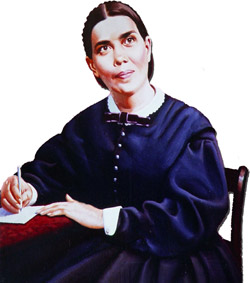Ellen G. White
|
|
Ellen Gould White (nee Harmon) (November 26,1827 – July 16,1915) was co-founder of Seventh-day Adventism. Most of her life she lived and worked in the United States, except for a period of 1890-1900 in Australia and some short visitations to Europe.
Ellen White was a prolific writer. She is said to be the most translated female writer in the history of literature and the most translated American author of either gender. Her writings covered topics of theology, evangelism, Christian lifestyle, education and health (she also advocated vegetarianism). She was a leader who emphasized education and health and promoted establishment of schools and medical centers.
During her lifetime she wrote more than 5,000 periodical articles and 40 books; but today, including compilations from her 50,000 pages of manuscript, more than 100 titles are available in English. Among her works is the popular Christian book, Steps to Christ.
Believed by Seventh-day Adventists to be inspired by God, she wrote books that have touched the lives of many, and have moved the hearts of men and women. Considered by some to be the prophetess for the end-times, through the Holy Spirit, she sought to draw more and more to studying the Word of God, and preparing the world for the Second Advent, or second coming of Christ.
Ellen G. White, though, is considered as a prophet only by Seventh Day Adventist believers and not at all by other Christians. One of the reasons is that her writings led to one more divisions in the Christian Church (the Body of Christ) and did not contribute to the unity among Christians. She even considered Christian unity to be from Satan and one of the big apostasies of the last days.
Her last home, Elmshaven in Saint Helena, California, is a National Historic Landmark.
Early Life
On her way home from school at the age of 9 years, Ellen Harmon was struck in the face with a rock thrown by another school girl. The trauma put her in a coma for three weeks, and gave her health problems she never fully recovered from. In her weakened state, she was unable to return to school, and never completed any further formal education.
In 1840, at age 12, her family became involved with the Millerite movement, a movement that created emotional turbulence for her. Through attending William Miller lectures, she felt that she was a guilty sinner and was filled with terror about being eternally lost. She describes herself as spending nights in tears and prayer, and being in this condition for several months. She also describes moments of pure bliss while having positive religious experiences. Eventually, the association with the Millerites eventually caused her Methodist church to disfellowship her and her family.
Visions
It was shortly after experiencing the Great Disappointment of 1844 that Ellen started having her first visions. At random times, often when in church or prayer meetings, Ellen would be taken into vision. The visions would last anywhere from a few minutes to a few hours.
She described the vision experiance as being surrounded in bright light. In these visions she would be in the presence of Jesus or angels, who would show her events (historical and future), show her places (on earth, in heaven, other planets), or tell her information. When the vision was over she described returning to the darkness of the earth.
The first vision was a depiction of the Adventist people following Jesus, marching to the city (heaven). This vision was taken by those around her as an encouraging sign considering the devestation of the Great Disappointment. She was encouraged both in visions and by fellow church members to more broadly share her visions, which she did by a mix of public speaking, magazine articles, and books.
The writings of her visions are generally either reproof or encouragement to individual people or the Adventist church collectively, theology, and prophecy. Her series of books "Testimonies for the Church" contain a large amount of this material. The speaking and writings of her visions were the more significant part she played in establishing and shaping the Seventh-day Adventist Church. Her visions were used, and are still used, in decision making, in forming policy and doctrine, as well as for devotional material.
Criticisms
One of the first and most prominent critics of Ellen White was D.M. Canright. The criticisms he makes in his 1919 book, "Life of Mrs. E.G. White Seventh-day Adventist Prophet Her False Claims Refuted" are largely the same as those pointed out by modern Ellen White critics. These include:
- plagiarism
- failed prophecy
- suppression of damaging writings
- progression of maturity in vision as she ages
- basing supposed visions on rumors
- visions incongruent with later scientific knowledge
- contradictions
- biblical contradictions
- hypocrisy
Many of her critics attribute her visions to her head injury, arguing that her symptoms match disorders such as temporal lobe epilepsy or mercury poisoning.

